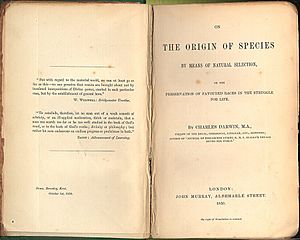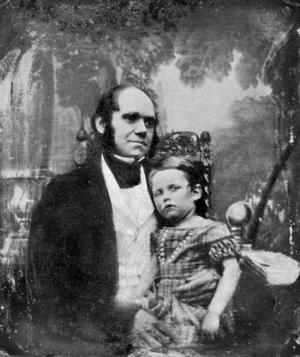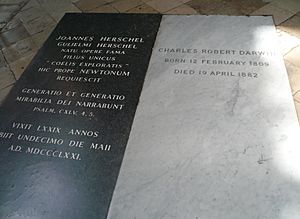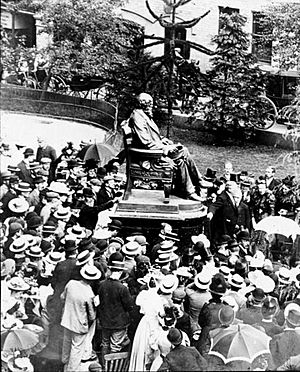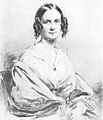Charles Darwin facts for kids
Quick facts for kids
Charles Darwin
|
|
|---|---|

Darwin, c. 1854 when he was working towards publication of On the Origin of Species
|
|
| Born |
Charles Robert Darwin
February 12, 1809 The Mount, Shrewsbury, Shropshire, England
|
| Died | April 19, 1882 (aged 73) |
| Known for | The Voyage of the Beagle On the Origin of Species |
| Spouse(s) | |
| Children | 10 |
| Scientific career | |
| Fields | Natural history, geology |
| Signature | |
 |
|
Charles Robert Darwin (February 12, 1809 – April 19, 1882) was an English naturalist. He was born in Shrewsbury, Shropshire. He is famous for his work on the theory of evolution.
Darwin's book On the Origin of Species was published in 1859. In it, Darwin suggested evidence that evolution has taken place. He also tried to explain how evolution works. Darwin's evolution theory is called natural selection. On the Origin of Species says that evolution and natural selection are the keys to understanding the diversity of life on Earth.
Contents
Early Life and Education
Charles Robert Darwin was born in Shrewsbury, Shropshire, on February 12, 1809, at his family's home, The Mount. He was the fifth of six children. His father was Robert Darwin, a wealthy society doctor, and his mother was Susannah Darwin. (Her maiden name was Wedgwood).
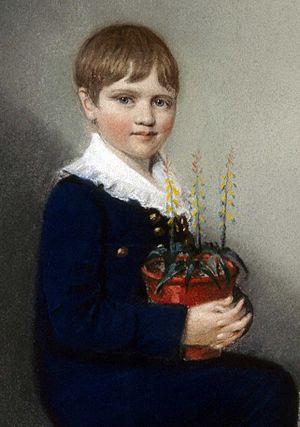
Eight-year-old Charles already enjoyed natural history and collecting when he joined the day school run by its preacher in 1817. That July, his mother died. In September 1818, he joined his older brother Erasmus at the nearby Anglican Shrewsbury School as a boarder.
Darwin spent the summer of 1825 as a doctor's apprentice. He helped his father treat the poor of Shropshire, before going to the University of Edinburgh Medical School in October of 1825. Darwin did not enjoy medical school, so he neglected his studies. He learned taxidermy in about 40 daily hour-long sessions from John Edmonstone, a freed black slave who had accompanied Charles Waterton in the South American rainforest.
Darwin's father thought he did not pay enough attention to his medical studies, so he sent Charles to Christ's College, Cambridge. Charles was to study to become an Anglican country parson. Darwin had to stay at Cambridge until June of 1831. He planned to visit Tenerife with some classmates after graduation to study natural history in the tropics. In preparation, he joined Adam Sedgwick's geology course. On August 4, Darwin traveled with Sedgwick to spend two weeks mapping strata in Wales.
Voyage of the HMS Beagle
Darwin spent almost five years aboard a Royal Navy exploring ship, the HMS Beagle. The voyage took place from December 1831 to October 1836. At the time, Britain had by far the largest navy in the world and an empire that owned and ruled land all over the world. One of the jobs of the Beagle was to make charts of all the coastal areas. Darwin was responsible for collecting and making notes about the animals, plants, and the geology of the countries they visited.
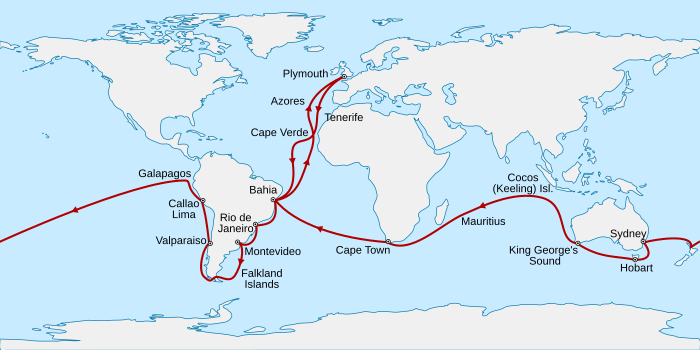
Plymouth, England, south to Cape Verde then southwest across the Atlantic to Bahia, Brazil, south to Rio de Janeiro, Montevideo, the Falkland Islands, round the tip of South America then north to Valparaiso, Chile, and Callao. Northwest to the Galapagos Islands before sailing west across the Pacific to New Zealand, Sydney, Hobart in Tasmania, and King George Sound in Western Australia. Northwest to the Keeling Islands, southwest to Mauritius and Cape Town, then northwest to Bahia and northeast back to Plymouth
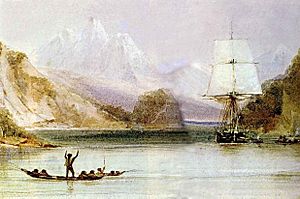
Darwin collected items everywhere the ship weighed anchor. He found huge fossils of recently extinct mammals. After experiencing an earthquake in Chile, he noticed the land had been raised. He knew of raised beaches elsewhere, high in the Andes, with fossil seashells and trees which had once grown on a sandy beach. He observed the earth was constantly changing, with land rising in some places and sinking in others. He collected birds and insects and sent shipments back to Cambridge for experts to identify.
Darwin was the first dedicated naturalist to visit the Galapagos Islands, off the west coast of Ecuador. He noticed that some of the birds were like mockingbirds on the mainland, but different enough to be placed in separate species. He began to wonder how so many new species (groups of similar plants or animals) came to be on these islands.
When Darwin got back to England, he edited a series of scientific reviews of the voyage and wrote a personal journal which we know as The Voyage of the Beagle. It is a famous natural history travel diary.
Darwin's Theory
Before Darwin
Before the nineteenth century, the accepted theory for the extinction of species was called Catastrophism. It stated that species went extinct due to catastrophes. These catastrophes were often followed by the formation of new species ex nihilo (out of nothing). The extinct species could then be found as fossils. The new species were considered unchangeable. This theory partially matched the Flood occurrence in the Bible.
In the early nineteenth century, several new theories started to compete with Catastrophism. One of the most important ones was developed by Jean-Baptiste Lamarck(1744-1829). He observed that every new generation inherits the traits of its ancestors. He suggested that traits or organs become enhanced with repeated use. He also suggested that traits or organs become weakened or even removed altogether when they are not used. Lamarck suggested that parents pass these improvements or losses directly to their offspring.
Evolution
While he was on H.M.S. Beagle, and later back home in London, Darwin came across the ideas of Rev. T.R. Malthus. Malthus had realized that, although humans were able to double their population every 25 years, it did not happen. He thought the reason was that a struggle for existence (or resources) caused them not to multiply. If population numbers increased, then famine, wars, and diseases caused more deaths. Darwin, who knew that all living things were able to increase their numbers, began to think about why some survived while others did not. His answer took years to develop.
Although Darwin started thinking about this in 1838, it took a full twenty years before his ideas became public. By 1844, he was able to write a draft of the main ideas in his notebook. Historians think that he did not talk about his theory because he was afraid of public criticism. He knew his theory, which did not discuss religion, challenged the truth of the Book of Genesis. In 1858, he heard that another biologist, Alfred Russel Wallace, had the same ideas about natural selection. Darwin and Wallace's ideas were first published in the Journal of the Linnaean Society in London, in 1858. Then, Darwin published his theory in a book the next year. The name of the book was On the Origin of Species by Means of Natural Selection, or the preservation of favored races in the struggle for life. This is usually called The Origin of Species.
The theory of evolution says that all living things on Earth, including plants, animals, and microbes, come from a common ancestor by slowly changing throughout the generations. Darwin suggested that the way living things changed over time is through natural selection. Those who fit best into their environment have the best chance to survive and breed. Fitting into the place where you live is called adapting. Those who are less well-adapted tend not to survive. If they do not survive well enough to raise young, this means they do not pass on their genes. In this way, the species slowly changes. Only the strongest genes get passed along to the next generations. This is sometimes called "survival of the fittest."
The first chapter of the Origin deals with domesticated animals, such as cattle and dogs. Darwin reminded readers of the huge changes mankind had made in its domestic animals, which were once wild species. The changes were made by selective breeding – choosing animals with desirable characters to breed from. This had been done generation after generation until our modern breeds were made. Darwin suggested that what man had done deliberately might happen in nature over a much longer time. He suggested the same for plants and other animals.
Darwin wrote several other books, most of which are also important.
Family
In 1843 Darwin, who already had two children with his wife Emma, bought Down House in the village of Downe, Kent. The Darwins had ten children: two died in infancy. Charles was a devoted father to his children.
Of his surviving children, George, Francis, and Horace became Fellows of the Royal Society. George was an astronomer, Francis was a botanist, and Horace was a civil engineer. All three were knighted. Another son, Leonard, went on to be a soldier, politician, economist, eugenicist, and mentor of the statistician and evolutionary biologist Ronald Fisher.
Death and Funeral
In 1882, Darwin was diagnosed with what was called "angina pectoris," which then meant coronary thrombosis and disease of the heart.
He died at Down House on April 19, 1882. His last words were to his family, telling Emma, "I am not the least afraid of death—Remember what a good wife you have been to me—Tell all my children to remember how good they have been to me." Then while she rested, he repeatedly told his children Henrietta and Francis, "It's almost worthwhile to be sick to be nursed by you."
The funeral was held on Wednesday, April 26, and was attended by thousands of people, including family, friends, scientists, philosophers, and dignitaries.
Legacy
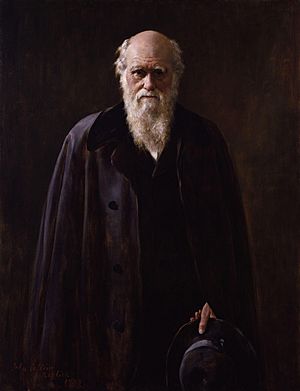
By the time of his death, Darwin and his colleagues had convinced most scientists that his theory of evolution was correct. He was regarded as a great scientist had revolutionized scientific ideas.
Commemoration

During Darwin's lifetime, many geographical features were given his name. An expanse of water adjoining the Beagle Channel was named Darwin Sound by Robert FitzRoy after Darwin and two or three other men saved their boats when from being swept out to sea by a collapsing glacier that created a large wave. The nearby Mount Darwin in the Andes was named in celebration of Darwin's 25th birthday. When the Beagle was surveying Australia in 1839, Darwin's friend John Lort Stokes sighted a natural harbor which the ship's captain Wickham named Port Darwin. A nearby settlement was renamed Darwin in 1911, and it became the capital city of Australia's Northern Territory.
Stephen Heard identified 389 species that have been named after Darwin. In one example, the group of tanagers (birds) similar to those Darwin found in the Galápagos Islands became commonly known as "Darwin's finches" in 1947. This started the legends about their importance to his work.
Darwin's work has continued to be celebrated by many publications and events. The Linnean Society of London has remembered Darwin's achievements by the award of the Darwin–Wallace Medal since 1908. Darwin Day is celebrated every year, and in 2009, worldwide events were prepared for the bicentenary (200th anniversary) of Darwin's birth and the 150th anniversary of the publication of On the Origin of Species.
Darwin has been commemorated in the U.K. by the Bank of England. His portrait, along with a hummingbird and HMS Beagle, is printed on the reverse side of £10 banknotes.
A life-size seated statue of Darwin can be seen in the main hall of the Natural History Museum in London.
A statue of Darwin is in front of Shrewsbury Library, the building that used to house Shrewsbury School, which Darwin attended as a boy. It was put there in 1897. Another statue of Darwin as a young man is located on the grounds of Christ's College, Cambridge.
Darwin College, a postgraduate college at Cambridge University, is named after the Darwin family.
Darwin's Down House and its contents are now open to the public.
Charles Darwin quotes
- “A scientific man ought to have no wishes, no affections, – a mere heart of stone.”
- “The mystery of the beginning of all things is insoluble by us; and I for one must be content to remain an agnostic.”
- "One general law, leading to the advancement of all organic beings namely, multiply, vary, let the strongest live and weakest die."
- "I am turned into a sort of machine for observing facts and grinding out conclusions."
Interesting facts about Charles Darwin
- Charles Darwin was born in England on the same day that Abraham Lincoln was born in Kentucky.
- He studied and ate exotic (rare or unusual) animals both at school and in his travels.
- Charles dropped out of medical school.
- Charles married his first cousin, Emma.
- He wrote a pro/con list on the subject of marriage.
- Darwin played backgammon with his wife every evening between 8 and 8:30 PM.
- The highest peak of Tierra del Fuego is named after him.
- His work On the Origin of Species by Means of Natural Selection was published twenty years after his travels.
- Herbert Spencer is the philosopher who coined the term "Survival of the Fittest," even though we think of Darwin when we hear that phrase.
Related pages
Images for kids
-
Bicentennial portrait by Anthony Smith of Darwin as a student, in the courtyard at Christ's College, Cambridge where he had rooms
-
Darwin (right) on the Beagle's deck at Bahía Blanca in Argentina, with fossils; caricature by Augustus Earle, the initial ship's artist.
-
In mid-July 1837 Darwin started his "B" notebook on Transmutation of Species, and on page 36 wrote "I think" above his first evolutionary tree.
-
Darwin chose to marry his cousin, Emma Wedgwood.
-
Darwin's "sandwalk" at Down House was his usual "Thinking Path."
-
Darwin aged 46 in 1855, by then working toward publication of his theory of natural selection. He wrote to Joseph Hooker about this portrait, "if I really have as bad an expression, as my photograph gives me, how I can have one single friend is surprising."
-
During the Darwin family's 1868 holiday in her Isle of Wight cottage, Julia Margaret Cameron took portraits showing the bushy beard Darwin grew between 1862 and 1866.
-
An 1871 caricature following the publication of The Descent of Man was typical of many showing Darwin with an ape body, identifying him in popular culture as the leading author of evolutionary theory.
-
Statue of Darwin in the Natural History Museum, London
See also
 In Spanish: Charles Darwin para niños
In Spanish: Charles Darwin para niños


